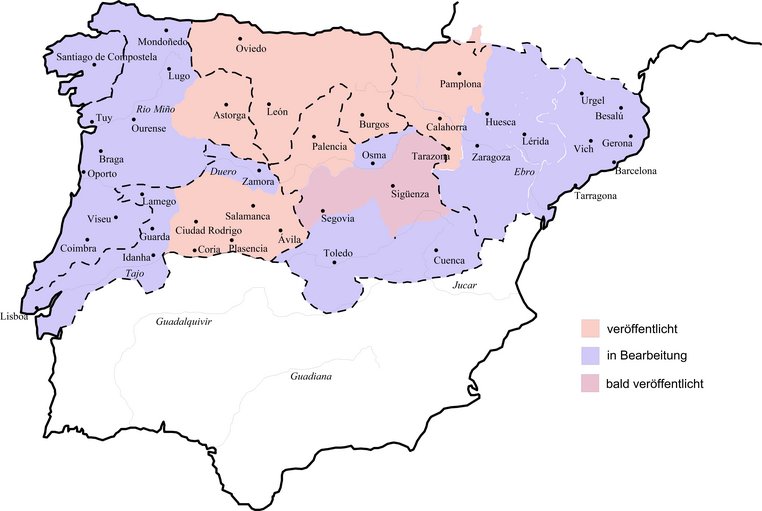![[Translate to English:] [Translate to English:]](/fileadmin/_processed_/a/f/csm_Papsturkunden_002_59ca3d4123.jpg)
Iberia
The sub-project 'Iberia Pontificia', in which external scholars are also involved, explores the relations of the papacy with the historical landscapes of Spain and Portugal up to the year 1198. For this purpose, all charters and other written news on contacts with the papacy are processed in the form of registers for each bishopric.
Iberia Pontificia
The Academies project encompasses work on the Iberia Pontificia, specifically the bishoprics of Astorga, Ávila, Burgos, Calahorra, Ciudad Rodrigo, Coria, Huesca, León, Oviedo, Palencia, Pamplona, Plasencia, Salamanca, Segovia and Sigüenza.
Dioecesis Abulensis (Frank Engel, M. A.)
Published 2016 as Iberia Pontificia IV (together with Coria, Ciudad Rodrigo, Palsencia and Salamanca).
Dioecesis Asturicensis (Prof. Dr. Santiago Domínguez Sánchez and Dr. Daniel Berger)
Published 2019 as Iberia Pontificia V (together with Oviedo).
Dioecesis Burgensis (Dr. Daniel Berger)
Published 2012 as Iberia Pontifica I.
Dioecesis Calagurritana (Frank Engel, M. A.)
Published 2022 as Iberia Pontificia VI (together with Pamplona and Tarazona).
Dioecesis Legionensis (Prof. Dr. Santiago Domínguez Sánchez with Dr. Daniel Berger)
Published 2013 as Iberia Pontificia II.
Dioecesis Palentina (Dr. Daniel Berger)
Published 2015 as Iberia Pontificia III.
Dioecesis Pampilonensis (Thomas Czerner, M. A.)
Published 2022 as Iberia Pontificia VI (together with Calahorra and Tarazona).
Dioecesis Salmanticensis, Cauriensis, Civitatensis, Placentia (Prof. Dr. José Luis Martín Martín with Frank Engel, M.A.)
Published 2016 as Iberia Pontificia IV (together with Ávila).
Dioecesis Segobiensis (Dr. Daniel Berger)
Segovia, already testified as a bishop's seat in Visigothic times, was subject to the Archbishop of Toledo after it had come under Christian rule again at the end of the 11th century. In the 1120s Segovia was restored as an independent diocese within the Toledo church province and the bishop's seat was confirmed by Pope Calixt II in 1123. Contacts with the papacy existed during the 12th century, particularly during a protracted conflict over the diocesan borders with the neighbouring diocese of Palencia.
So far, around 130 draft regests have been prepared.
Dioecesis Tirasonensis (Frank Engel, M. A.)
Published 2022 as Iberia Pontificia VI (together with Calahorra and Pamplona).
Cooperations
The Academy project is working closely with a research enterprise funded by the Spanish Ministry of Science. The following researchers are involved in the project coordinated by Prof. Dr. Fernando López Alsina (Santiago de Compostela) entitled 'El Papado y sus relaciones con la sociedad y los reinos de la Península Ibérica (ss. VIII-XIII): protagonistas, tipos de contactos, problemas y consecuencias integradoras (I)':
- Prof. Dr. Fernando López Alsina (Santiago de Compostela)
- Prof. Dr. Cristina Cunha (Porto)
- Prof. Dr. María João Branco (Lissabon)
- Prof. Dr. José Luis Martín Martín (Salamanca)
- Prof. Dr. Eduardo López Pereira (La Coruña)
- Prof. Dr. José Manuel Diáz de Bustamante (Santiago de Compostela)
- Dr. Luis Miguel de la Cruz Herranz (Madrid)
The following researchers in Germany are associated with the project:
- Prof. Dr. Klaus Herbers (Erlangen)
- Dr. Daniel Berger (Göttingen)
- Dr. Andreas Holndonner (Erlangen)
- Frank Engel, M. A. (Göttingen/Bonn)
- Thomas Czerner, M. A. (Göttingen/Hannover)
Further cooperation exists with the project Corpus Documentale Latinum Gallaeciae (CODOLGA), which makes the Latin-language medieval historiography of Galicia accessible as a digital text corpus.

